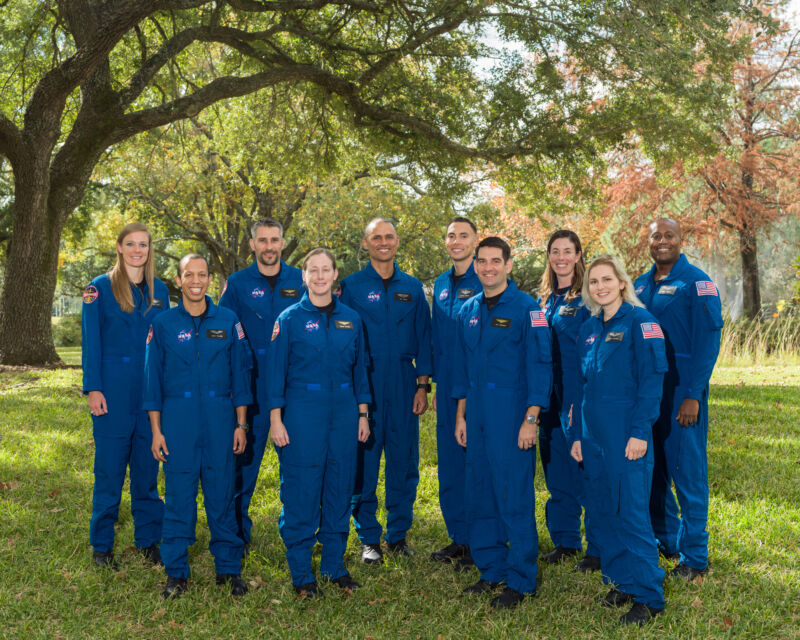"We're always looking for smart, dedicated people in their current fields."
ERIC BERGER - 12/7/2021, 12:19 PM

Enlarge / Meet the new astronaut-candidates: US Air Force Maj. Nichole Ayers, Christopher Williams, US Marine Corps Maj. (retired) Luke Delaney, US Navy Lt. Cmdr. Jessica Wittner, US Air Force Lt. Col. Anil Menon, US Air Force Maj. Marcos Berríos, US Navy Cmdr. Jack Hathaway, Christina Birch, US Navy Lt. Deniz Burnham, and Andre Douglas.
NASA
This week, NASA announced its first class of new astronauts since 2017, hiring 10 candidates to train at Johnson Space Center in Houston for the next two years.
There is no guarantee that each of these six men and four women, ages 32 to 45 and all with extremely impressive resumes, will complete the training and become full-fledged astronauts. But one thing is clear: They're arriving at NASA at an auspicious time.
"This is the golden age of human spaceflight," said Reid Wiseman on Monday during a ceremony at an airfield near Johnson Space Center welcoming the new astronaut candidates.
Wiseman would know. Now chief of the astronaut office, Wiseman was selected in August 2009. At that time, the space shuttle was due to retire. Neither he nor any of his classmates would fly on the US vehicle. The majority of them would make their first spaceflight on a Russian Soyuz spacecraft. And at the time there was no coherent deep-space exploration plan—nominally NASA was on a "journey to Mars," which was mocked as a "journey to nowhere." The classes of 2013 and 2017 also faced similar uncertainty.
FURTHER READING NASA has selected its deep space hardware—now comes the fun part
But now NASA has SpaceX's Crew Dragon spacecraft to fly four people at a time into low Earth orbit. And within the next two years, Boeing's Starliner spacecraft should come online. By the mid-2020s, NASA's Orion spacecraft will also enter service, and SpaceX is also developing its large Starship vehicle for Moon landings and more. Never before in its history will NASA have so many human spaceflight vehicles available.
And while NASA has vibrant research ongoing at the International Space Station, it also has a pretty solid plan for lunar exploration with the Artemis program. Many of the 10 people who walked onto the stage inside a T-38 maintenance hangar Monday will probably walk on the Moon within the next 10 or 15 years.
Wiseman, who led the selection process, said the agency sought people with a wide range of skill sets, who can do everything from grow protein crystals on the space station to drill for water on the surface of the Moon.
"We're always looking for smart, dedicated people in their current fields," Wiseman said in an interview after the ceremony. "We want team players, people that we know we can send up to the space station, or to the surface of the Moon, and get along with the team. And we want to know when we're picking you, that you have the kind of the motivation and the prowess to get the job done. These people are all complex problem solvers, and they are all team players."
The new astronaut candidates, accordingly, came from a variety of backgrounds to NASA, from the traditional test pilots to oil drilling to national championship track cycling.
"You might think that my path as a bioengineer and a cyclist is a little bit out there, but it was really all of those skills that I gained from those experiences that helped me get here,” said Christina Birch, 35, who has a doctoral degree in biological engineering from the Massachusetts Institute of Technology and won the US individual cycling pursuit title in 2016 and 2017.
NASA also sought to select a diverse group of people who were representative of the whole country. The new astronauts came from across the United States, from Puerto Rico to Alaska, from a variety of ethnic backgrounds.
"We really want every little kid growing up in America to look at the NASA Astronaut Office and see themselves projected into the future," Wiseman said. "That's very important to us. We were extremely lucky this time that we had a fantastic, diverse group of candidates that came out and just crushed it."
NASA selected the latest class from more than 12,000 applicants. Wiseman said out of those there were 500 people he could easily have selected to become astronauts. NASA gave the authority to select up to a dozen people, but these 10 stood head and shoulders above the rest. The agency will probably select another class in 2025, when the Artemis program begins to ramp up.
No comments:
Post a Comment